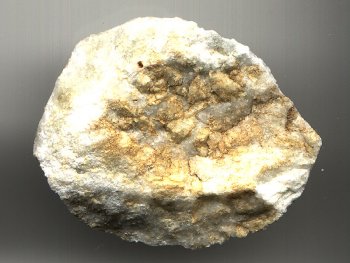carbonate

Figure 1. Dolomite.
A carbonate is a salt or ester of carbonic acid, H2CO3, containing the carbonate ion [CO3] 2-. A solution of carbon dioxide in water reacts with a base to form a carbonate.
The carbonates of the alkali metals and alkaline earth metals are stable (the latter insoluble). Most other metal carbonates are precipitated as basic carbonates, e.g. 2PbCO3·Pb(OH)2. All carbonates except the alkali metal carbonates lose carbon dioxide on strong heating.
Carbonate esters are important solvents.
The bicarbonates (hydrogen carbonates) contain the [HCO3] - ion and important salts include NaHCO3 and Ca(HCO3)2. Bicarbonates are formed by the action of carbon dioxide on carbonates in aqueous solution; this reaction is reversed on heating. Dissolved calcium and magnesium bicarbonates give rise to hard water.
Carbonate minerals
Carbonates are common rock-forming minerals, occurring as calcite and limestone (both calcium carbonate, CaCO3), siderite (FeCaCO3), magnesite (MgCO3), dolomite (CaMg(CO3)2), and ankerite (Ca(Fe,Mg,Mn)(CO3)2).
Dolomite
Dolomite is a carbonate mineral consisting of a mixed calcium-magnesium carbonate, CaCO3.MgCO3, crystallizing in the rhombohedral system (Figure 1). It is usually white or colorless. The term is also used to denote a rock with a high ratio of magnesium to calcium carbonate. Dolomite is often found associated with limestone or marble and in magnesium-rich metamorphic rocks. Dolomitic limestone is a rock in which the limestone has been partially replaced by dolomite.
Dolomite is used as an ornamental and building stone, and is a source of magnesium. Hardness 3.5–4, relative density 2.8.


